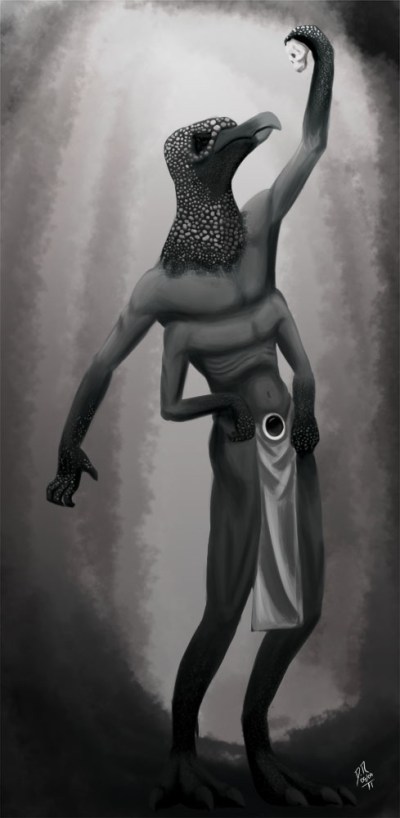
Tash is the antithesis of Aslan the lion. In The Last Battle he’s the principal god of Calormen, a horrid epitome of an ancient Middle Eastern deity who receives sacrificial victims in bizarre and novel ways, like being tied up inside a brass bull which is heated by a wood-burning fire from below. He’s cut from the whole cloth of the Bible as much as Jadis is. Historically, he’s Moloch, Marduk, and Tanis combined… though in truth Lewis must have have been most influenced by Nisroch, an Assyrian deity with an eagle’s head.

Nisroch
Pauline Baynes was the first to illustrate Tash and her vision is the iconic one. Her Tash is skeletal yet ornate, wearing a wide metal collar, earrings, and a headress, with a fancy loincloth covering his privates and a tattered, fluttering cape. He has cat’s paws for feet but his hands are the talons of a predatory bird, and though unwinged he bristles with sharp, curving spines. Though described in the text as vulture-headed, his beak resembles that of an ibis, like the Egyptian god Thoth.

Tash, ink drawing by Pauline Baynes
It’s not a bad depiction of an ersatz-Middle Eastern god. But Baynes’s depiction owes more to Aztec than Assyrian history. Her Tash looks more like an Eagle Warrior, the elite of the Aztec Emperor’s fighting force.

Aztec Eagle Warrior
All those spiny things coming out of Tash’s back are really decorative feathers like those on a Las Vegas showgirl. I guess the part about a bloody human sacrifice on an altar influenced her. And the mass blood sacrifices of the Aztecs certainly were horrifying, though they did not think of them that way.
In any case, Rishda Tarkaan is correct to be out of his mind in fright at seeing a being he had long dismissed as a plebian conceit in the live and actual flesh. Bayne’s drawing is horrific, but it’s humorous too. A dark humor and perhaps the darkest she got in the series.

This version of Tash adheres to Bayne’s in its depiction of the god’s feet, collar, and headdress, but here he seems a more active, wily, and athletic opponent, like a giant crow. Not bad but also not as alien and horrific.

This Tash is more Nisroch than Aztec warrior, even being modeled in stone. It’s creepy to think of a giant stone statue gliding slowly through the forest without means of propulsion. I like it.

A nearly-naked Tash with a vulture’s head as described in Lewis’s text and zombielike, rotting flesh exposing his ribcage.

A humorous but very angry Tash wearing chain mail. Again, he keeps the headress, earrings, and collar.

This takes the prize as the weirdest Tash… a giant skeleton that is crumbling apart even as it advances, and a head resembling a Styracosaurus skull.

Tash regards his enemy face to face in this Lovecraftian depiction. Note the pyramid and eye symbol on his belt buckle lifted from American currency.

This must be an Indian edition of The Last Battle, as Tash looks more than a little like Garuda.

A supremely weird but effective Tash with his head covered in a cowl of barnacles or pebbles.

Woodpecker Tash? But I like the energy of this one even though he’s missing the extra pair of arms.
 This idol isn’t Tash — it’s a god of Carthage from the 1914 Italian silent film Cabiria. But with its golden plating, oversized scale, and army of spectators watching a sacrificial rite, it could be straight from the book.
This idol isn’t Tash — it’s a god of Carthage from the 1914 Italian silent film Cabiria. But with its golden plating, oversized scale, and army of spectators watching a sacrificial rite, it could be straight from the book.
